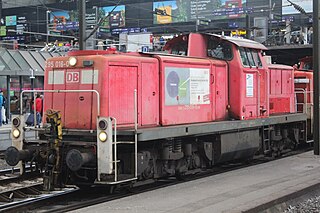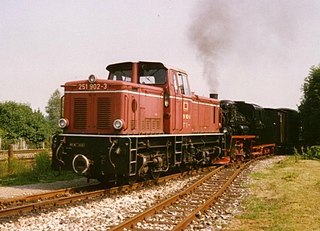Vossloh AG is a rail technology company based in Werdohl in the state of North Rhine-Westphalia, Germany. The SDAX-listed group has achieved sales of around €930 million in 2016 and, as of 2017, had more than 4,000 employees.

The Eurotunnel Class 0001 Bo-Bo diesel-electric locomotives were built by Maschinenbau Kiel between 1991 and 1992. They are very similar to the NS Class 6400. When operating in the United Kingdom, the locomotives are assigned a TOPS classification as Class 21.

NSB Di 6, later designated ME 26 and DE 2700, is a class of twelve diesel-electric locomotives built by Siemens for the Norwegian State Railways (NSB). The prime mover provides a power output of 2,650 kilowatts (3,550 hp), a starting traction effort of 400 kilonewtons (90,000 lbf) and a maximum speed of 160 kilometres per hour (99 mph). They have a Co′Co′ wheel arrangement. The bidirectional locomotives were designed for use with both passenger and freight trains.

The NSB Di 8 is a class of diesel-electric locomotives built by Maschinenbau Kiel (MaK), while it was part of Siemens Schienenfahrzeugtechnik, for the Norwegian State Railways (NSB). The locomotives are equipped with a Caterpillar 3516 DI-TA prime mover, which provides a power output of 1,570 kilowatts (2,110 hp) and a starting tractive effort of 270 kilonewtons (61,000 lbf).

The NMBS/SNCB Class 77 is a class of 4 axle B'B' road switcher diesel hydraulic locomotive designed for shunting and freight work manufactured at the beginning of the 2000s by Vossloh Schienentechnik/Vossloh Locomotives at the Maschinenbau Kiel plant in Kiel, Germany for the National Railway Company of Belgium (SNCB/NMBS).

The Voith Maxima locomotives are a family of diesel-hydraulic locomotives built by Voith Turbo Lokomotivtechnik GmbH & Co. KG., a subsidiary of Voith.

These DB Class V 100 diesel locomotives were produced in the late 1950s by the Deutsche Bundesbahn for non-electrified branch lines as a replacement for steam locomotives. The V 100 class was built in three different variants.

The DB Class 218 are a class of 4-axle, diesel-hydraulic locomotives acquired by the Deutsche Bundesbahn for use on main and secondary lines for both passenger and freight trains.

The Voith Gravita locomotives are a family of road switcher diesel-hydraulic locomotives built by Voith Turbo Lokomotivtechnik GmbH & Co. KG. Available in a range of configurations from 4 to 6 axles, they are designed for shunting and light and medium freight operations.

The DB Class V90 locomotive is a German diesel-hydraulic locomotive for shunting and freight hauling.

The Vossloh G1206 is a B'B' diesel hydraulic freight locomotive built in Kiel and used by several European railway operators including a SNCF specific variant the BB 461000 series.

The DB Class 240 are a class of Co′Co′ diesel-electric locomotives which were produced in the 1980s by MaK in collaboration with Krupp and ABB as DE 1024 as prototypes/technology demonstrators for a possible future order from the Deutsche Bundesbahn.

The DB Class V 51 and DB Class V 52 are classes of almost identical narrow gauge 4 axle diesel hydraulic locomotives built in 1964 for the Deutsche Bundesbahn, being built for 750 mm and 1,000 mm gauge lines respectively.

The Vossloh G1700 BB is a four axle B′B′ medium power diesel-hydraulic locomotive manufactured by Vossloh Locomotives GmbH. in Kiel.

The ÖBB 2070 is a class of 90 shunting and light multipurpose four axle B'B' Diesel-hydraulic locomotive built for the Austrian Federal Railways by Vossloh at the MaK locomotive plant in Kiel, Germany.

The MaK G 1205 is a class of four axle B'B' diesel-hydraulic locomotives built by the Maschinenbau Kiel factory.

The Vossloh G1000 BB is a class of off-centre cab diesel-hydraulic B'B' 4 axle locomotives built by Vossloh in Kiel since 2002. When operating under Swiss ownership the locomotives have received the class Am 842, several units owned by the Société Nationale des Chemins de Fer Luxembourgeois are classified as CFL class 1100.

The Vossloh G6 is a C diesel-hydraulic shunting locomotive, and the first locomotive of Vossloh's fifth generation programme. The G6 is the successor of the MaK/Vossloh G765, a third generation MaK locomotive still offered in the 2000s.

The VSFT G322 is a B diesel-hydraulic shunting locomotive, initially built for and in service with the Danish State Railways (DSB) as Class MK.

The second use of the TOPS classification Class 21 for locomotives used on the British railway network came through the use of a number of related diesel-hydraulic and diesel-electric locomotives procured following the opening of the Channel Tunnel. The total of 16 locomotives were obtained by two separate operators, with some used for freight, and others to propel service trains and as "Thunderbird" locomotives.






















